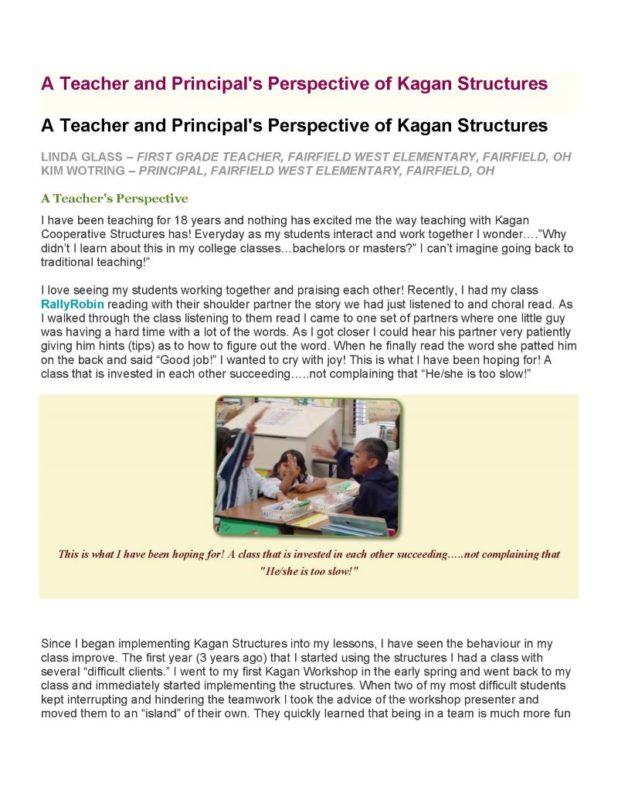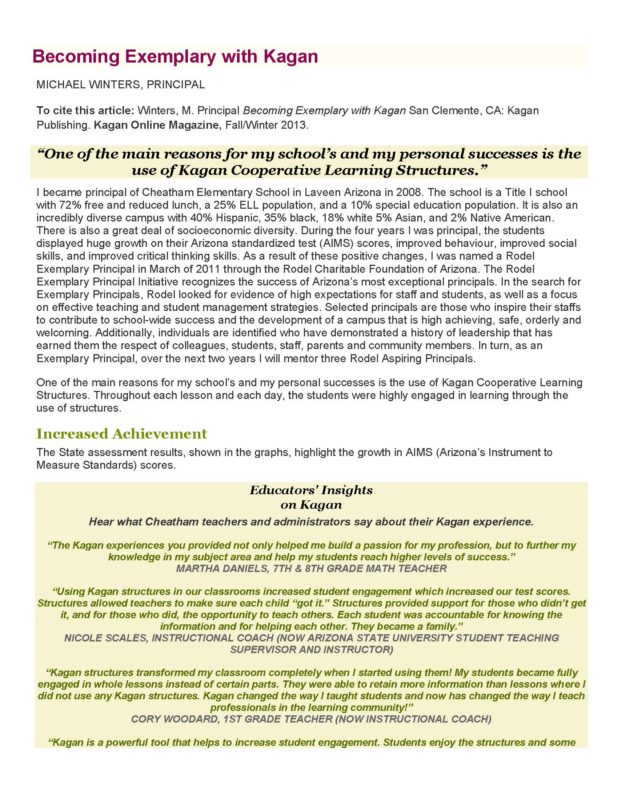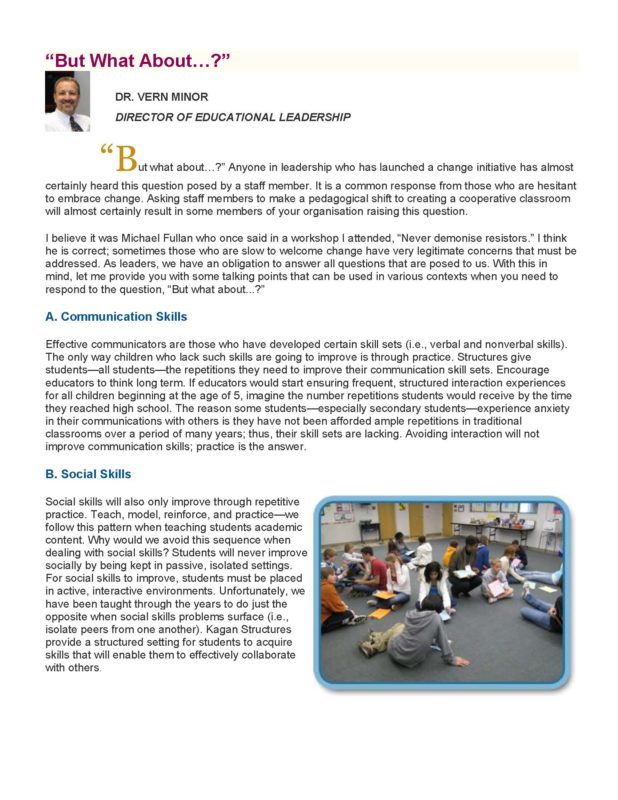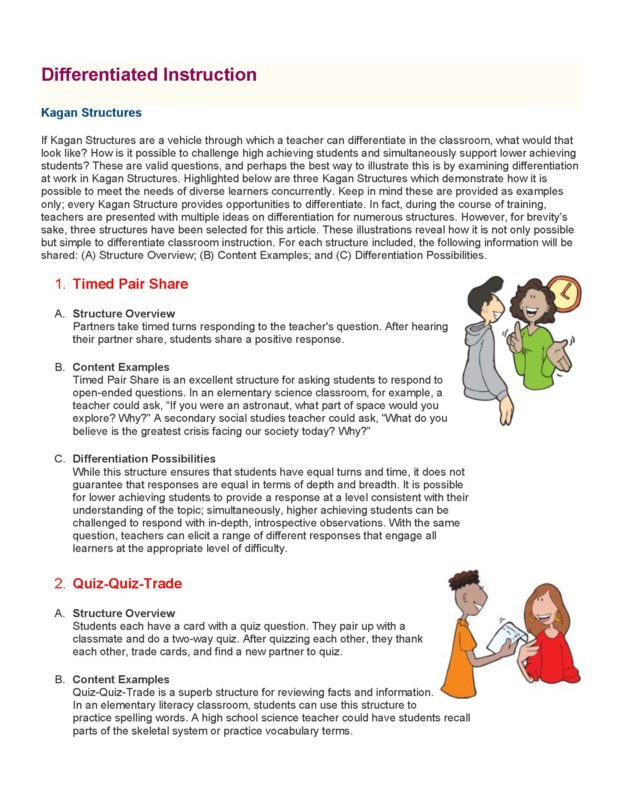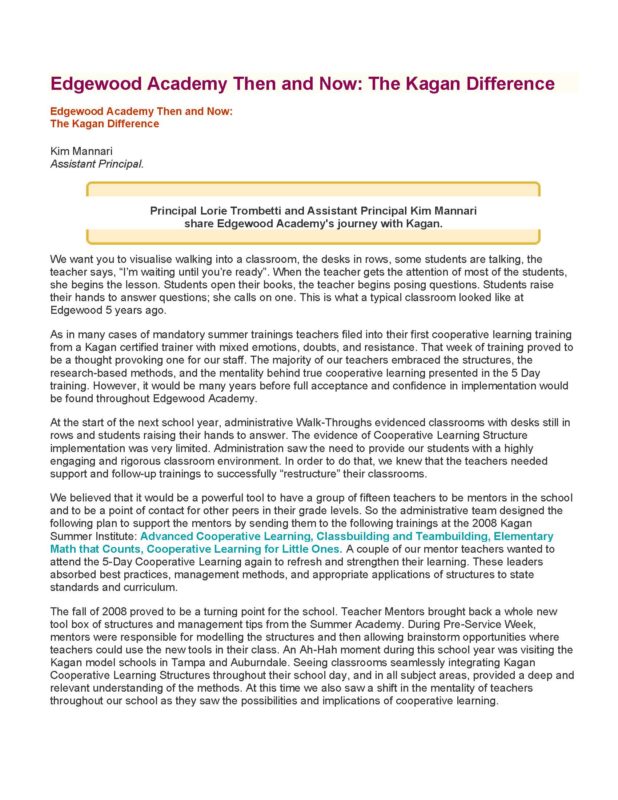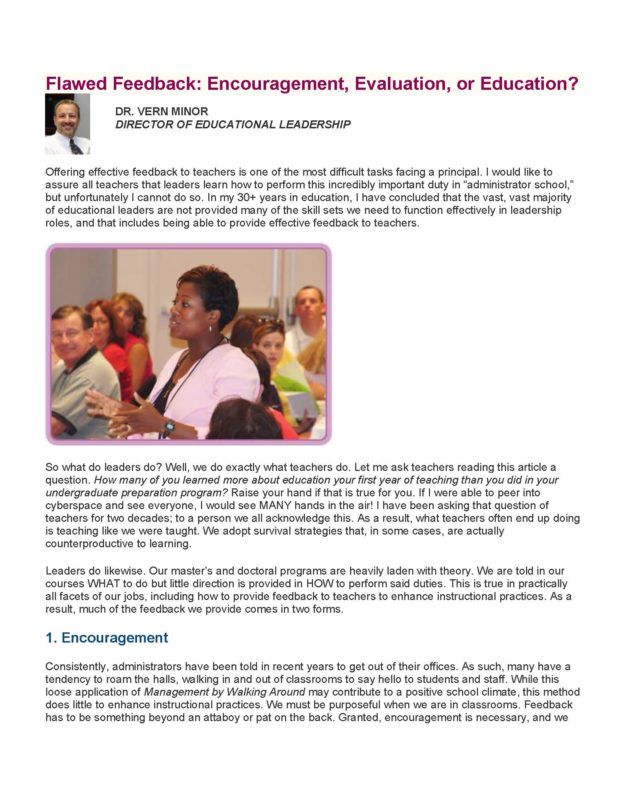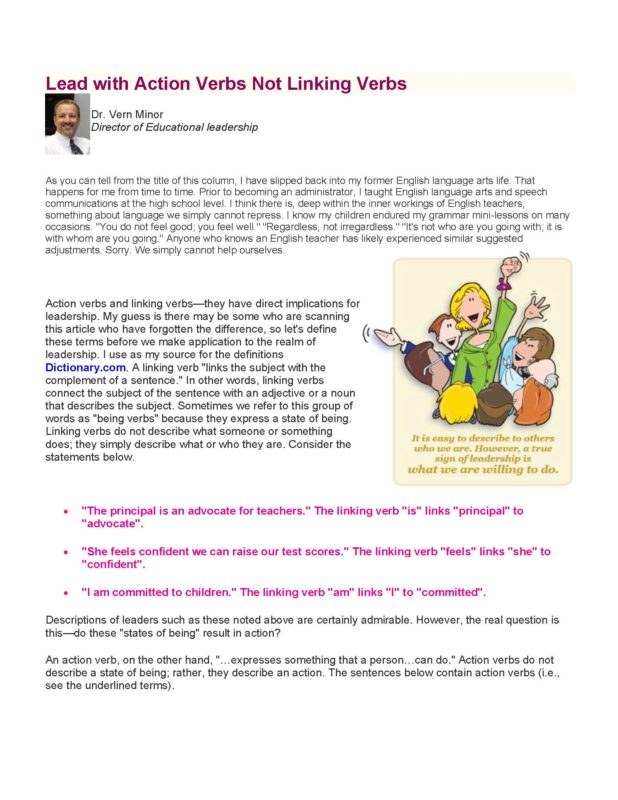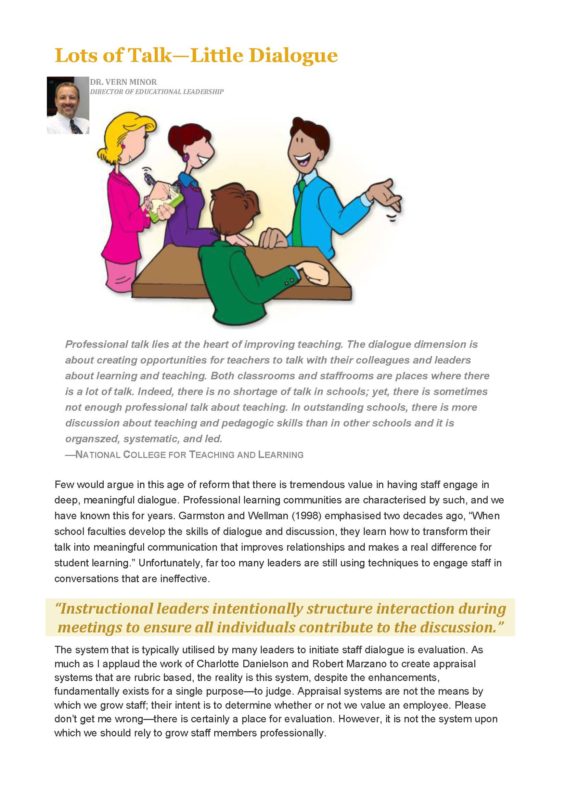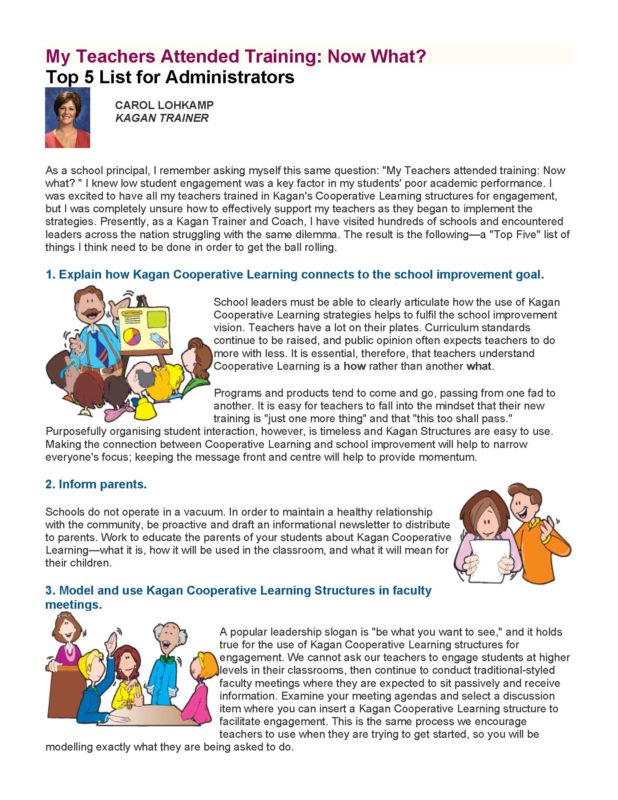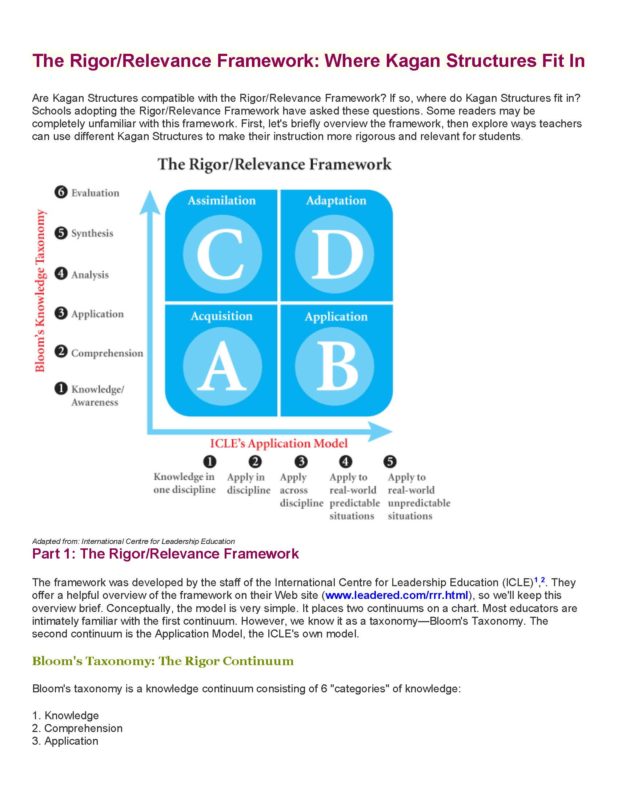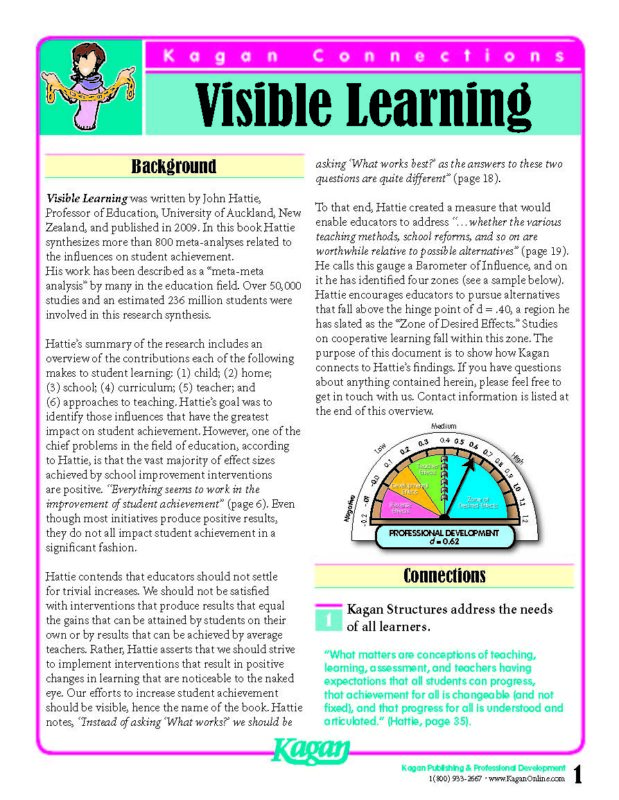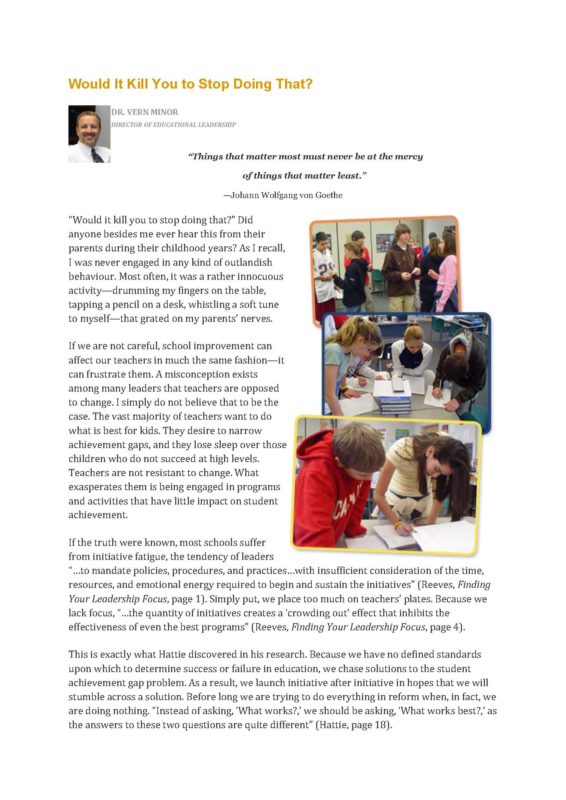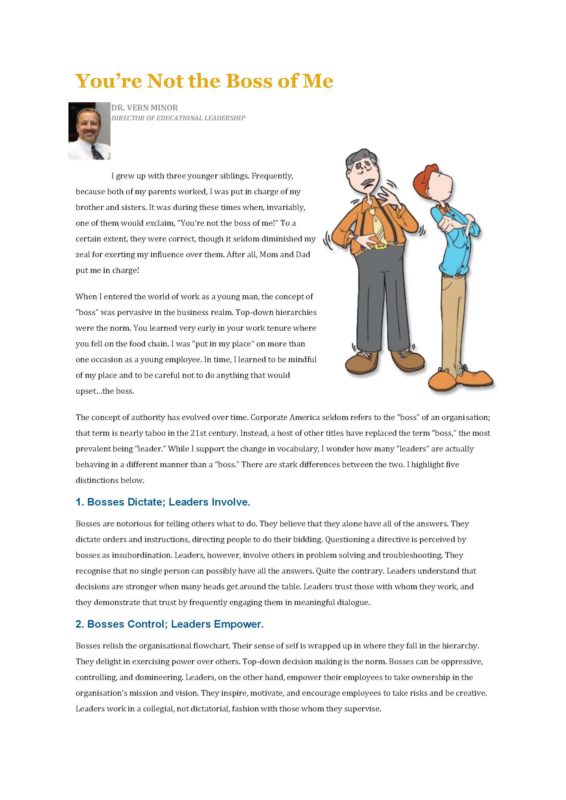Leading Implementation of Cooperative Learning
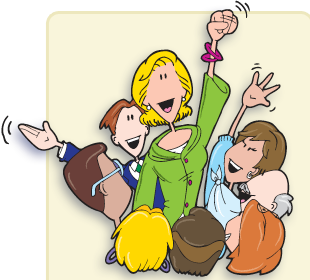
These are articles written by educators & school leaders.
This collection of articles is for principals, deputy principals, school executive, coordinators of curriculum and faculties and other instructional leaders interested in boosting student engagement and learning with Kagan’s approach to teaching.
You will find educational leaders tips, informative articles connecting Kagan Cooperative Learning to other educational initiatives and articles by fellow leaders celebrated for their achievements by implementing Kagan Cooperative Learning at their school or district.
A Teacher’s Perspective
I have been teaching for 18 years and nothing has excited me the way teaching with Kagan Cooperative Structures has! Everyday as my students interact and work together I wonder….”Why didn’t I learn about this in my college classes…bachelors or masters?” I can’t imagine going back to traditional teaching!”
A Principal’s Perspective
When I walk into a classroom and the teacher is implementing a Kagan Structure into his/her lesson, the learning climate feels different, in a really amazing way. I just want to scream, “Yes! This is exactly what I want to see! I could stay in here and watch this learning take place all day long!”
Read ArticleThis expression was first uttered to me by my wife, Dr. Jacqueline Minor, Director of District Implementation for Kagan Professional Development. I am not sure where she first heard the saying, but from the moment she voiced these words, they stuck with me. Be what you want to see! What a marvellous mantra for those of us in a leadership role, particularly when it comes to issues surrounding student engagement. It is critical for leaders to send a consistent message to staff.
Read ArticleA shift in leadership style is essential today from authoritative and coercive to democratic and participative. This shift is not unique to education; corporate America made this transition long before education. “Business has been moving for many years—and it will continue to do so—from a posture and a practice of management through power to a process of leadership through persuasion” (DePree, pages 21-22). The business realm refers to this style of leadership as participative management or consultative management. In education, we call this instructional leadership and creating professional learning communities.
Read ArticleHow did the use of Kagan Structures become so ingrained in the school’s instructional culture? Here’s how.
- High Expectations
- Mandated Kagan Training
- Cooperative Staff Meetings
- Coaching & Feedback
- Extensive Kagan Support Resources
- Creatinga Culture of Success
Read Article
But what about…?” Anyone in leadership who has launched a change initiative has almost certainly heard this question posed by a staff member. It is a common response from those who are hesitant to embrace change. Asking staff members to make a pedagogical shift to creating a cooperative classroom will almost certainly result in some members of your organisation raising this question.
- Communication Skills
- Social Skills
- Content of Structures
- Safety
- Timed Structures
If Kagan Structures are a vehicle through which a teacher can differentiate in the classroom, what would that look like? How is it possible to challenge high achieving students and simultaneously support lower achieving students? These are valid questions, and perhaps the best way to illustrate this is by examining differentiation at work in Kagan Structures.
Highlighted below are three Kagan Structures which demonstrate how it is possible to meet the needs of diverse learners concurrently. Keep in mind these are provided as examples only; every Kagan Structure provides opportunities to differentiate. In fact, during the course of training, teachers are presented with multiple ideas on differentiation for numerous structures.
However, for brevity’s sake, three structures have been selected for this article. These illustrations reveal how it is not only possible but simple to differentiate classroom instruction. For each structure included, the following information will be shared: (A) Structure Overview; (B) Content Examples; and (C) Differentiation Possibilities.
Read ArticleWe want you to visualise walking into a classroom, the desks in rows, some students are talking, the teacher says, “I’m waiting until you’re ready”. When the teacher gets the attention of most of the students, she begins the lesson. Students open their books, the teacher begins posing questions. Students raise their hands to answer questions; she calls on one. This is what a typical classroom looked like at Edgewood 5 years ago.
This article details how Edgewood changed.
Read ArticleOffering effective feedback to teachers is one of the most difficult tasks facing a principal. I would like to assure all teachers that leaders learn how to perform this incredibly important duty in “administrator school,” but unfortunately I cannot do so. In my 30+ years in education, I have concluded that the vast majority of educational leaders are not provided many of the skill sets we need to function effectively in leadership roles, and that includes being able to provide effective feedback to teachers.
Read ArticleTeachers using the Kagan Structures consistently report that their students are more engaged. This is no surprise. Kagan Structures are carefully designed to implement the four basic principles of cooperative learning: positive interdependence, individual accountability, equal participation, and simultaneous interaction (PIES). Each of these principles boosts engagement in different ways, ensuring, for example, participation from students who might otherwise hide and ensuring that at any one moment a greater number of students are actively engaged.
Read ArticleFew would argue in this age of reform that there is tremendous value in having staff engage in deep, meaningful dialogue. Professional learning communities are characterised by such, and we have known this for years. Garmston and Wellman (1998) emphasised two decades ago, “When school faculties develop the skills of dialogue and discussion, they learn how to transform their talk into meaningful communication that improves relationships and makes a real difference for student learning.” Unfortunately, far too many leaders are still using techniques to engage staff in conversations that are ineffective.
Read ArticleAs a school principal, I remember asking myself this same question: “My Teachers attended training: Now what? ” I knew low student engagement was a key factor in my students’ poor academic performance. I was excited to have all my teachers trained in Kagan’s Cooperative Learning structures for engagement, but I was completely unsure how to effectively support my teachers as they began to implement the strategies. Presently, as a Kagan Trainer and Coach, I have visited hundreds of schools and encountered leaders across the nation struggling with the same dilemma. The result is the following—a “Top Five” list of things I think need to be done in order to get the ball rolling.
Read ArticleAre Kagan Structures compatible with the Rigor/Relevance Framework? If so, where do Kagan Structures fit in? Schools adopting the Rigor/Relevance Framework have asked these questions. Some readers may be completely unfamiliar with this framework. First, let’s briefly overview the framework, then explore ways teachers can use different Kagan Structures to make their instruction more rigorous and relevant for students.
Read ArticleVisible Learning was written by John Hattie, Professor of Education, University of Auckland, New Zealand, and published in 2009. There are connections that can be made between Hattie’s findings and Kagan. In this article five connections demonstrate that Kagan Structures will enable educators to more effectively implement instructional strategies supported by educational research. If we as educators hope to close the achievement gap and ensure high levels of learning for ALL students, we must embrace changes in our instructional practices.
Read Article“Would it kill you to stop doing that?” Did anyone besides me ever hear this from their parents during their childhood years? As I recall, I was never engaged in any kind of outlandish behaviour. Most often, it was a rather innocuous activity—drumming my fingers on the table, tapping a pencil on a desk, whistling a soft tune to myself—that grated on my parents’ nerves.
If we are not careful, school improvement can affect our teachers in much the same fashion—it can frustrate them. So what is the answer?
Read ArticleThe concept of authority has evolved over time. Corporate America seldom refers to the “boss” of an organisation; that term is nearly taboo in the 21st century. Instead, a host of other titles have replaced the term “boss,” the most prevalent being “leader.” While I support the change in vocabulary, I wonder how many “leaders” are actually behaving in a different manner than a “boss.” There are stark differences between the two.
I highlight five distinctions in this article.
Read Article
